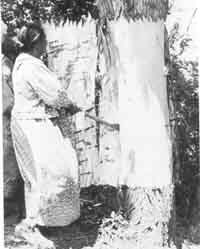American Prehistory: 8000 Years of Forest Management

OVERVIEW
American Prehistory has students study the evidence of 8000 years of Native American prehistoric land use practices. By analyzing images of Native American material culture, students will understand how artifacts and architecture reveal environmental attitudes of the culture. Students also will learn about the difficulties historians and other scholars face when attempting to study people who had no written language.
Image Caption: A Potawatomi woman in Kansas strips bark from a living elm tree. First a serrated ring is cut around the tree, then strips are peeled off with the aid of a wedge or ax. Photo courtesy of Native American Architecture, Peter Nabokov, New York: Oxford University Press, 1989, p. 62.
OBJECTIVE
History
- The student will understand the patterns of indigenous societies in the Americas before the Columbian voyages. (Era 1, Standard 1)
- The student will explain and give examples of how language, literature, the arts, architecture, other artifacts, traditions, beliefs, values, and behaviors contribute to the development and transmission of culture. (Standard 1: Culture)
- The student will draw upon historical knowledge during the examination of social issues and develop the habits of mind that historians and scholars in the humanities and social sciences employ to study the past and its relationship to the present in the United States and other societies. (Standard 2: Time, Continuity and Change)
Social Studies
LESSON PLAN
For Day 1 activity: Make copies of the essay "American Prehistory: 8000 Years of Forest Management" for each student in your classroom. Next make copies of Worksheet 1 and Worksheet 2 for each student.
Day 2 activity: Make copies of Detecting Prehistory and Worksheet 3 for each student. Pre-class preparation: Arrange four tables or four clusters of desks within the classroom. Place one 8"x12" colored category topic card on or above each table or desk cluster. The category topic cards, each a different color, are entitled: Archaeologists, Anthropologists, Geographers, and Historians. Print each of the category topics on 4"x6" unlined note cards. (The total number of 4"x6" cards represents the total number of students in your class). The 4"x6" note card color for each category topic should match that of the larger 8"x12" card. For example, if the 8"x12" anthropology topic card is blue, the 4"x6" anthropology cards also should be blue.
Day 3 activity: Make copies of Eyewitness Accounts and Worksheet 4 for each student.
Day 4 activity: Make copies of "The Legend of the Cedar" for each student and Worksheet 5 for each student group (groups of 3-4).

